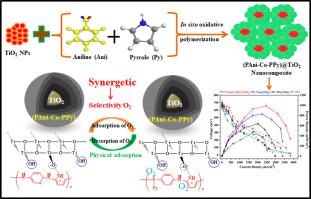Biomaterials Advances ( IF 7.9 ) Pub Date : 2020-09-06 , DOI: 10.1016/j.msec.2020.111492 Prasanta Pattanayak , Farhan Papiya , Vikash Kumar , Amandeep Singh , Patit Paban Kundu

|
A simple, inexpensive in situ oxidative polymerization of aniline and pyrrole using ammonium persulfate (APS) as oxidant and hydrochloric acid (HCl) as dopant has been used to synthesize a hybrid (PAni-Co-PPy)@TiO2 nanocomposite with titanium oxide (TiO2) nanoparticles (NPs) wrapped into (PAni-Co-PPy) copolymer. The synthesized nanocomposite has been shown with higher oxygen reduction reactions (ORR) as an excellent cathode material for higher performance in the complex of (PAni-Co-PPy)+/TiO2(O−). The charge transport phenomenon between TiO2 and (PAni-Co-PPy)+ were found adequate with subsequent delocalization of electron/s at PAni and PPy. The self-doping nature of TiO2 (O−) played a vital role in oxygen adsorption and desorption process. With higher electrical conductivity and surface area, these were tested in microbial fuel cells (MFCs) for ORRs at cathode. This yielded a relatively higher current and power density output as compared to PAni@TiO2, PPy@TiO2, and commercially available Pt/C cathode catalysts in MFC system. In overall, the prepared (PAni-Co-PPy)@TiO2 nano-hybrid cathode delivered ~2.03 fold higher power density as compared to Pt/C catalyst, i.e. ~987.36 ± 49 mW/m2 against ~481.02 ± 24 mW/m2. The properties of electro-catalysts established an improved synergetic effect between TiO2 NPs and (PAni-Co-PPy). In effect, the enhanced surface area and electrochemical properties of the prepared (PAni-Co-PPy)@TiO2 nano-hybrid system is depicted here as an effective cathode catalyst in MFCs for improved performance.
中文翻译:

聚苯胺共吡咯包裹的二氧化钛纳米复合材料作为微生物燃料电池空气阴极催化剂的性能评价
使用过硫酸铵(APS)作为氧化剂和盐酸(HCl)作为掺杂剂的苯胺和吡咯的简单,便宜的原位氧化聚合反应已被用于合成具有氧化钛的杂化(PAni-Co-PPy)@TiO 2纳米复合材料包裹在(PAni-Co-PPy)共聚物中的TiO 2)纳米粒子(NPs)。将合成的纳米复合材料已显示出具有较高的氧还原反应(ORR),为优异的正极材料获得更高的性能在复杂(PANI的Co-PPY)的+ /的TiO 2(O - )。TiO 2与(PAni-Co-PPy)+之间的电荷传输现象被发现足够用于随后在PAni和PPy处电子的离域。TiO 2的自掺杂性质2(O - )起到氧的吸附和解吸过程中的重要作用。具有较高的电导率和表面积,已在微生物燃料电池(MFCs)中测试了阴极上的ORR。与PAni @ TiO 2,PPy @ TiO 2和MFC系统中可商购的Pt / C阴极催化剂相比,这产生了相对较高的电流和功率密度输出。总体而言,与Pt / C催化剂相比,制备的(PAni-Co-PPy)@TiO 2纳米杂化阴极的功率密度高约2.03倍,即约987.36±49 mW / m 2,相对于〜481.02 ±24 mW / 2米。电催化剂的性质在TiO 2 NP和(PAni-Co-PPy)之间建立了改善的协同作用。实际上,在此将所制备的(PAni-Co-PPy)@TiO 2纳米杂化体系的表面积和电化学性能提高表示为MFC中提高性能的有效阴极催化剂。



























 京公网安备 11010802027423号
京公网安备 11010802027423号